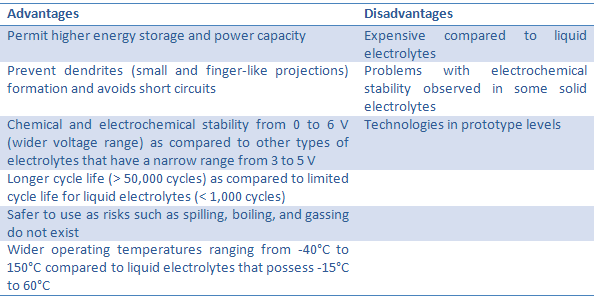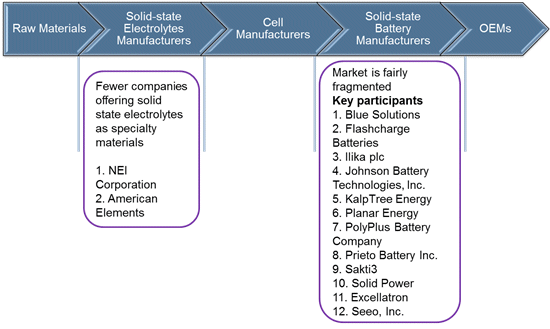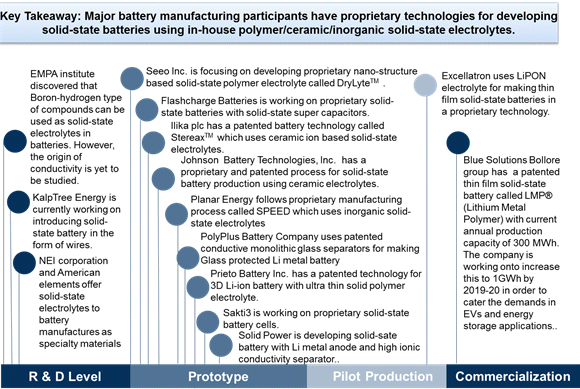Road to Solid-state Battery
Lithium Ion Battery (LIB) is by far the most promising, efficient, and fastest growing battery chemistry in the market as it offers high energy density and superior mechanical properties. This battery remains a preferred choice for miniaturized devices. The electrolyte plays a critical role in the battery as it transfers ions from one electrode to another. Electrolytes are required to have high ionic conductivity, negligible electronic conductivity, and superior chemical and electrochemical stability. Key selection criteria for electrolytes include cost competitiveness, safety features, and functional capability over a wide voltage range.
Conventionally, the electrolytes for LIB are organic, aprotic, and solvent-based. However, the spewing of hot electrolyte vapors from a cell at high temperatures and voltages presents a potential explosion hazard. This combustion hazard observed in liquid electrolytes is mitigated by using either low flammability solvents or flame retardant additives. In addition, low charge retention and operational difficulties at low and high temperatures are the other key challenges associated with liquid electrolytes. To address these challenges, the industry is looking at solid-state electrolytes by eliminating flammable solvents, thereby improving safety along with providing other advantages. Solid-state electrolytes contain 100% materials in the solid form.
Advantages and Disadvantages
Table 1: Solid-state Electrolytes Market: Advantages and Disadvantages of Solid-state Electrolytes, Global, 2017

Types of Solid Electrolyte
Exhibit 1: Solid-state Electrolytes Market: Types of Solid-state Electrolytes, Global, 2017

Value Chain Analysis
The exhibit below represents the value chain of solid-state batteries production. There are very few participants operating in the solid-state electrolyte landscape. These companies offer specialty battery materials to either cell manufacturers or solid-state battery manufacturers. An interesting trend in the value chain is that solid-state battery manufacturers prefer in-house production and consumption of solid-state electrolytes to gain a competitive edge in the marketplace. The group of solid-state battery manufacturers developing proprietary solid-state electrolytes remains much higher when compared to the group of electrolyte manufacturers developing electrolyte materials.
The low market concentration of solid-state electrolyte material manufacturers could be associated to the lack of technical know-how and the increased preference among battery manufacturers to develop materials in-house. Entry barriers in the market remain fairly high as extensive efforts are required to start research and development of such products and then extensive time is needed to commercialize them.
Exhibit 2: Solid-state Electrolytes Market: Value Chain Analysis and List of Key Participants, Global, 2017

Focus Areas of Market Participants
Most of the battery manufacturing companies have proprietary and patented processes in developing solid-state batteries by using in-house solid-state ceramic/polymer/inorganic-based electrolytes, and key participants, such as Blue solutions, Bollore, and Excellatron have already started production and pilot production lines of battery cells, respectively. Other market participants, such as Johnson Battery Technologies Inc., Ilika plc, Prieto Battery, Sakti3, PolyPlus battery, Flashcharge batteries, Seeo, Planar Energy, KalpTree Energy, and Solid Power are in either prototype stages or seeking partners for licensing their technologies to explore commercialization avenues for specific end applications.
Blue Solutions is currently producing solid-state batteries with the capacity of 300 MWh and plans to increase the production capacity to 1GWh by 2019-2020 to cater to the demand in electric vehicles and energy storage systems. The company’s technology is based on a proprietary LMP® (Lithium Metal Polymer) thin film solid-state battery made by extrusion technique. This company has a portfolio of more than 1000 registered patents.
Excellatron has developed thin film batteries by using LiPON, which is an inorganic solid electrolyte with the thickness of around 5 µm. This can be used in many end applications where low-discharge, high power output, and long durability are required. The company has established a pilot production with multiple in-line deposition systems delivering a current production capacity of 10,000 cells/month. It is also looking further to expand the capacity to 100,000 cells/month. Excellatron also has a portfolio of 20 patents filed with 10 patents issued on thin film batteries.
Exhibit 3: Solid-state Electrolytes Market: Current Competitive Structure and Technological Status Analysis, Global, 2017

Conclusion
Solid-state electrolytes are safer alternatives to conventional liquid and gel electrolytes as they prevent leakage of electrolytes and dendrite formation as compared to liquid electrolytes that are associated with the risk of short circuit and combustion. Solid-state electrolytes further offer superior functional performances and stability over a wide voltage and temperature window. Market participants from North America and Europe are at the forefront in terms of developing solid-state batteries through in-house proprietary solid-state materials and processes. This can be primarily attributed to the technological know-how and sophistication among North American and European participants.
Solid-state batteries and materials are likely to gain adoption primarily in automotive and energy storage applications. Market participants are further seeking active partnerships for developing prototypes and testing methodologies for steering the deployment of solid-state batteries in other applications such as consumer electronics and industrial segments.



